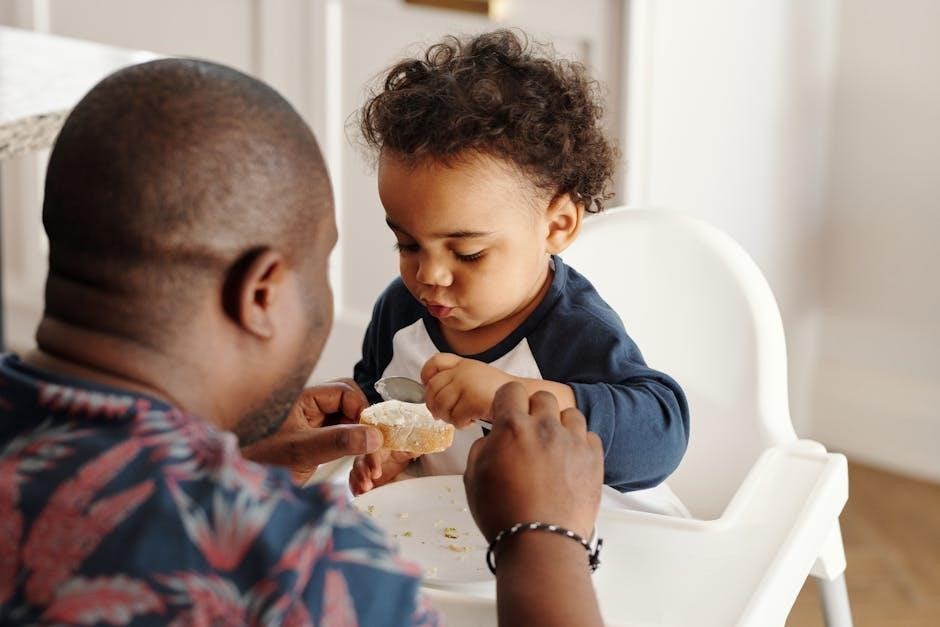
Traveling with children offers a unique opportunity to bond, explore new cultures, and create lasting memories. It fosters independence, curiosity, and adaptability in kids while allowing families to grow together. However, it also presents challenges like planning, safety, and keeping children entertained. With proper preparation and mindset, family travel can be a rewarding experience for all ages.
1.1. Benefits of Family Travel
Family travel fosters bonding, creates lifelong memories, and broadens children’s perspectives. It encourages adaptability, curiosity, and cultural awareness, helping kids develop empathy and understanding. Traveling together allows parents to witness their children’s growth in new environments, strengthening family ties. It also offers educational opportunities, teaching history, geography, and social skills through real-world experiences. These shared adventures can inspire a love for exploration and shape a child’s worldview, making family travel a valuable investment in their personal development and future outlook.

1.2; Challenges Parents Face While Traveling with Kids
Traveling with children presents unique challenges, including keeping them entertained, managing tantrums, and ensuring their safety. Fatigue, hunger, and boredom can escalate quickly, requiring patience and creativity. Parents must also navigate unpredictable schedules, like delayed flights or long waits, while catering to their children’s needs. Additionally, finding age-appropriate activities and maintaining routines, such as sleep schedules, can be stressful. These challenges demand careful planning, flexibility, and the ability to think on your feet, all while ensuring a enjoyable experience for the whole family.

Planning the Trip
Planning a family trip involves researching destinations, setting budgets, and organizing activities to ensure a smooth and enjoyable journey for all ages.
2.1. Choosing Family-Friendly Destinations
When selecting destinations for family travel, consider kid-friendly activities, safety, and amenities. Look for places with parks, museums, and attractions suitable for all ages. Ensure accommodations offer family rooms or suites. Research destinations with gentle climates and minimal travel time to reduce stress. Involve children in the decision-making process to build excitement. Check reviews for family-friendly ratings and tips from other parents. Prioritize destinations with medical facilities and easy access to essentials, ensuring a smooth and enjoyable trip for everyone.
2.2. Packing Essentials for Kids
Packing for kids requires thoughtful preparation to ensure comfort and entertainment. Essentials include a travel journal, pens, and a small organizer for creative expression. Don’t forget extra clothes, toiletries, and a first-aid kit. Comfort items like a favorite toy or blanket can ease travel stress. Include snacks, a reusable water bottle, and a tablet with educational apps. A portable charger and kid-friendly headphones are must-haves. Pack a small backpack for daily outings and a change of clothes in case of spills. Organize everything neatly to keep kids entertained and parents stress-free during the journey.
2.3. Creating a Flexible Itinerary
A flexible itinerary is key to stress-free family travel. Balance structured activities with downtime to accommodate kids’ energy levels and unpredictable moods. Include a mix of kid-friendly attractions, outdoor play, and relaxation. Involve children in planning to keep them excited and invested. Build in buffer times for spontaneity and unexpected delays. Don’t overschedule—leave room for serendipitous moments. A flexible plan ensures everyone stays happy and adaptable, making the trip enjoyable for all ages. Remember, the goal is to create memories, not stick to a rigid schedule.

Safety and Health
Prioritize health and safety by ensuring vaccinations, packing medications, and staying informed about local conditions. Maintain hygiene and be vigilant to secure your child’s well-being while traveling.
3.1. Health Precautions for Children While Traveling
Ensuring your child’s health while traveling requires careful planning. Consult a pediatrician to discuss vaccinations and medications. Pack essentials like fever reducers, antihistamines, and band-aids. Teach kids to wash hands frequently and avoid unsafe foods. Stay hydrated and protect against insect bites. Research local health risks and carry a first-aid kit. Consider motion sickness remedies and ensure your child wears a seatbelt or uses a car seat. A well-prepared health plan ensures a safer and more enjoyable trip for your family.
3.2. Emergency Preparedness
Being prepared for emergencies while traveling with children is crucial. Carry a well-stocked emergency kit with essentials like a first-aid kit, flashlight, and extra snacks. Ensure all family members have important documents like passports and health insurance cards easily accessible. Program local emergency numbers and establish a meeting point in case of separation. Stay informed about local conditions and potential risks. Teach children basic safety rules and how to seek help. Having a plan in place helps minimize stress and ensures everyone’s safety during unexpected situations.
3.3. Kid-Friendly Accommodations
Choosing kid-friendly accommodations is essential for a stress-free family trip. Look for hotels or rentals with amenities like cribs, high chairs, and playgrounds. Ensure the space is safe, with features like stair gates and soft flooring. Opt for family suites or apartments with separate living areas to accommodate kids’ energy and sleep needs. Many resorts offer kid clubs, babysitting services, and activities tailored for children. Proximity to attractions and dining options with children’s menus can also enhance the experience. Prioritizing these factors ensures a comfortable stay for the whole family.
Engaging Children During Travel
Engage children with age-appropriate activities, educational opportunities, and interactive experiences. Encourage curiosity, exploration, and learning while creating lasting memories through shared adventures and meaningful interactions.
4.1. Age-Appropriate Activities for Kids
Engage children with activities tailored to their age and interests. For toddlers, sensory play and exploration are ideal. Preschoolers enjoy interactive games and storytelling. Older kids benefit from hands-on learning, DIY projects, and outdoor adventures. Teenagers can participate in cultural immersions, photography, or journaling. Always consider their energy levels and attention spans when planning. Incorporating educational elements, like visiting museums or historical sites, can make travel both fun and enriching. These activities ensure a memorable and enjoyable experience for all ages.
4.2. Educational Opportunities in Travel
Travel offers countless opportunities for children to learn about history, culture, and the environment. Visiting museums, historical sites, and nature reserves provides hands-on learning experiences. Engaging in local workshops, such as cooking classes or art sessions, fosters cultural understanding. Encourage kids to observe and participate in traditions, festivals, or community activities. These experiences broaden their perspectives, teaching them about diverse lifestyles and global interconnectedness. Travel becomes a living classroom, enriching their education beyond textbooks and fostering a deeper appreciation for the world.
4.3. Managing Screen Time During Trips
Managing screen time during trips is essential to ensure kids engage with their surroundings. Set clear limits on device usage and encourage outdoor activities or reading. Use travel apps or games that align with educational goals. Encourage family bonding through shared experiences rather than individual screens. Offer alternatives like travel journals or scavenger hunts to keep them occupied. Balance entertainment with exploration to create meaningful memories and foster a connection with the world around them.

Financial Planning
Effective financial planning ensures family trips are enjoyable without overspending. Budgeting, seeking discounts, and investing in travel insurance are key strategies for stress-free adventures.
5.1. Budgeting for Family Travel
Budgeting for family travel involves tracking expenses, allocating funds for essentials like accommodations, meals, and activities, and prioritizing spending based on family preferences. Start by estimating costs for destination, transportation, and lodging. Consider setting aside a portion for unexpected expenses. Using budgeting apps or spreadsheets can help monitor spending. Families should also weigh the value of pre-booked tours versus free activities. Creating a realistic budget ensures a stress-free trip, allowing everyone to enjoy the experience without financial strain. Planning ahead helps balance indulgence with practicality.
5.2. Discounts and Family-Friendly Travel Passes
Families can save significantly by utilizing discounts and travel passes designed for children and groups. Many attractions, transport systems, and accommodations offer reduced rates for kids or bundle deals for families. For example, railway passes like the Eurail Youth Pass or city-specific options like the Paris Museum Pass provide cost-effective access to multiple attractions. Additionally, some airlines and hotels offer family discounts or free stays for children under certain ages. Researching these options beforehand can help maximize savings, making family travel more affordable and enjoyable for all members.
5.3. Travel Insurance for Families
Travel insurance is a crucial aspect of family travel, offering protection against unexpected medical emergencies, trip cancellations, and lost luggage. Many policies provide coverage for children at no additional cost, ensuring financial security for the entire family; Parents should look for plans that include age-related benefits and flexible coverage options. Comparing different insurance providers can help families find the most suitable and cost-effective solution, ensuring peace of mind while exploring the world together.

Cultural and Language Immersion
Cultural and language immersion helps children broaden their perspectives by exposing them to new traditions, languages, and ways of life, fostering global understanding and adaptability.
6.1. Teaching Kids About Local Cultures
Teaching children about local cultures involves encouraging curiosity and exploration. Families can engage kids by visiting cultural landmarks, attending festivals, and trying traditional foods. Parents should explain historical contexts and traditions, fostering appreciation for diversity. Interactive activities, like learning a few phrases in the local language or participating in workshops, can deepen their understanding. This exposure helps children develop empathy and a broader perspective of the world, making travel a valuable educational experience.
6.2. Language Tips for Families Traveling Abroad
Learning a few basic phrases in the local language can enhance family travel experiences. Encourage kids to greet locals in their native tongue, fostering cultural connections. Use translation apps or phrasebooks for quick communication. Teach children key phrases like “thank you” or “where is the bathroom?” to empower them. Immersive language learning apps designed for kids can also be helpful. Speaking the local language, even imperfectly, shows respect and can lead to warmer interactions during your travels.
6.3. Respecting Local Etiquette
Teach children to respect local customs and traditions, such as dressing modestly for religious sites or understanding table manners. Encourage them to remove shoes when required or use polite gestures like bowing in certain cultures. Explain why respecting these norms is important, fostering cultural sensitivity. Small actions, like learning a few local phrases, can also show respect. Modeling respectful behavior yourself helps kids adopt these practices naturally, making your family travels more harmonious and enriching for everyone involved.

Documenting and Sharing the Experience
Documenting travels through journals and photos preserves memories and allows families to reflect on their adventures. Sharing stories with others fosters connection and inspires future journeys.
7.1. Keeping a Family Travel Journal
A family travel journal is a meaningful way to document adventures and memories. It can include photos, ticket stubs, and notes from each family member, creating a personalized record of experiences. Encouraging children to write or draw about their favorite moments fosters reflection and creativity. Over time, the journal becomes a cherished keepsake, allowing families to revisit their travels and share stories with others. It’s a simple yet powerful tool for preserving the essence of your journeys together.
7.2. Capturing Memories Through Photography
Photography is a powerful way to preserve family travel memories. Encourage everyone to participate, capturing moments from different perspectives. Use natural lighting, candid shots, and creative compositions to tell your story. Consider creating a shared album or scrapbook for collective memories. Teaching children about photography can also spark their creativity and appreciation for the world around them. These visual mementos will become treasured family heirlooms, allowing you to relive your adventures for years to come.
7.3. Sharing Travel Stories with Others
Sharing travel stories with others fosters connection and inspiration. Families can bond by recounting adventures, highlighting each member’s experiences. Use journals, photos, or videos to create engaging narratives. Sharing online or with friends sparks curiosity and joy. It also preserves memories and motivates others to explore. Encourage open conversations, allowing everyone to reflect on their journey. This practice not only strengthens family bonds but also inspires others to embark on their own adventures, creating a lasting impact.